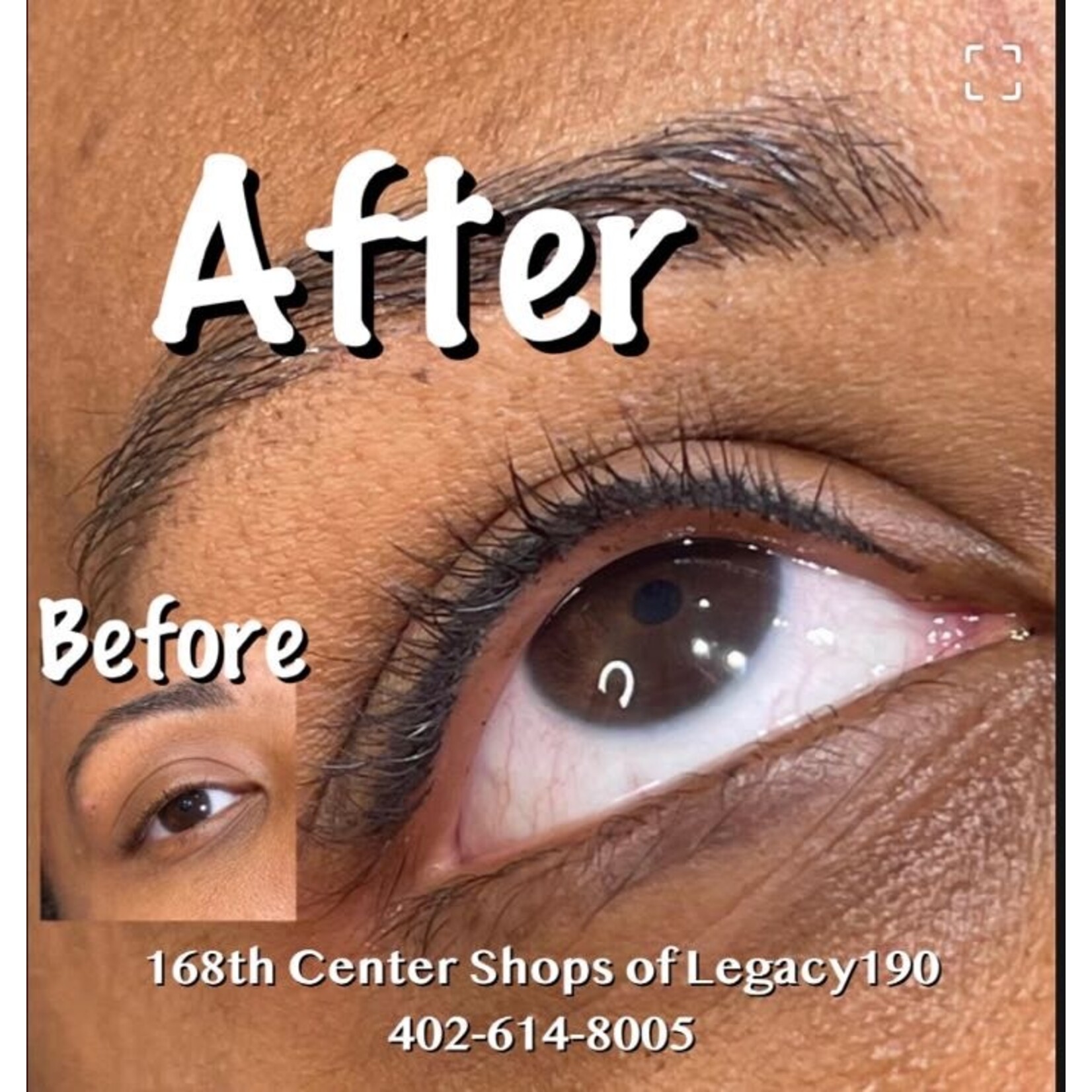|
If you are sick of applying daily makeup, want to have a more precise eyeliner line, or can’t achieve the perfect eyeliner, permanent makeup may be for you.
But before you undertake an eyeliner tattoo procedure, read our comprehensive guide to eyeliner cosmetic micropigmentation. |
|
What Is Eyeliner Tattoo?
Eyeliner tattoo is a form of cosmetic tattooing, often referred to as semi-permanent makeup, that is done by a trained technician.
The pigment used is very different from body tattooing ink and is only deposited on the first layer of skin. The colour is designed to fade over time, hence the term ‘semi-permanent’. This allows for face changes, ageing and trends.
The tattoo is applied to the lash line, and can be applied as a fine, thin, or medium to thick eye-liner style.
The pigment used is very different from body tattooing ink and is only deposited on the first layer of skin. The colour is designed to fade over time, hence the term ‘semi-permanent’. This allows for face changes, ageing and trends.
The tattoo is applied to the lash line, and can be applied as a fine, thin, or medium to thick eye-liner style.
Benefits of Eyeliner Tattoo
There are many benefits to eyeliner tattooing, including:
- It’s smudge-proof and waterproof
- It accentuates your eye shape and color without the need for traditional makeup eyeliner.
- You don’t need to apply eyeliner every day!
What’s The Difference Between Cosmetic Tattooing and A Traditional Tattoo?
Although the process is similar to getting a regular tattoo, there are some key differences:
- Eyeliner tattoo is only applied to the first layers of skin, so the colour fades over time. Traditional skin tattoo ink goes much deeper into the skin.
- It is only semi-permanent, lasting approximately 12-18 months, with a yearly ‘touch up’ usually required
- It is less painful than a regular skin art tattoo
- Cosmetic tattoo inks contain less of a metal base, which is the component that allows ink to permanently adhere.
Eyeliner Tattoo Styles
There are four different eyeliner styles you can choose between, along with extra trendy options such as ‘wings’.
Wings are more of a ‘trend’ style, however, you need to be very careful about doing wings as there is a 'no go' zone where glands are located on the inner and outer edges of the eye. If you tattoo in this area, because of the small molecules in the pigment, it's possible to get migration of colour and spreading, which is very bad and impossible to remove. Wings are also hard to maintain as your eyes change with age.
- Eyelash enhancement: Super Subtle
Eyelash enhancement is a very subtle tattoo application and it can be done in two different ways – as either a thin line that does not leave the lash area or as a dot next to each eyelash. This makes your eyelashes look longer and thicker. - Thin eyeliner: Subtle but impactful
Thin eyeliner application can still make your eyes pop, whilst keeping a more ‘natural’ look. It’s a great option for those that want a thin eyeliner line, with the option of building it up further with makeup. - Medium-width eyeliner: Bold
A medium-width eyeliner is perfect for women who wear makeup every day and want a look that makes their eyes bold but still relatively natural. - Thick eyeliner: Super-Bold
Thick eyeliner is not for everyone. For those who wear thick makeup and eyeliner daily, this will give you a permanently bold eyeliner look.
Wings are more of a ‘trend’ style, however, you need to be very careful about doing wings as there is a 'no go' zone where glands are located on the inner and outer edges of the eye. If you tattoo in this area, because of the small molecules in the pigment, it's possible to get migration of colour and spreading, which is very bad and impossible to remove. Wings are also hard to maintain as your eyes change with age.
Preparation Before Your Procedure
- Lash Extensions
You need to remove lash extensions at least one to two days – or ideally a week – before your procedure to give lash extension glue time to disappear. Even small amounts of lash glue can interfere with the application of ink. You can reapply your lash extensions once your tattoo has healed. - Natural Blood Thinners
Stop taking as aspirin, fish oil, and other ‘natural’ products that thin the blood for at least three days prior to your procedure. If you take prescription blood thinners, consult your doctor for advice. - Contact Lenses
Remove contact lenses before your procedure, and don’t put them back in until any tenderness or redness has vanished. - Consult a doctor
If you are on any prescription medications, consult a doctor prior to your procedure.
The Procedure
- The technician will confirm the design and look you have previously agreed on
- The procedure commences with your eye being cleaned with a cotton swab and makeup remover
- A numbing cream is then applied to ensure a comfortable and pain-free procedure
- Your technician will use gloves and magnifying eyeglasses for hygiene and accuracy
- The technician will slowly inject the pigment into your skin with a tattooing needle. A digital tattoo machine and small gauge needles to create the fine lines and shadowing is used by most expert tattooists.
- Your technician will move back and forth over small sections of your lash line in order to make the pigment fix.
Does Eyeliner Tattoo Hurt
A numbing cream is applied to the area prior to your eye tattoo procedure, which should make the whole process relatively painless. Some people with sensitivity or a lower pain threshold may find the procedure mildly uncomfortable, but generally most client’s experience little or no pain.
How Long Does the Procedure Take
The procedure usually takes approximately 2-3 hours, including the numbing process (approximately 30 minutes). A traditional look usually takes less time, however a stronger eyeliner, wing or cat eye could take 2 - 3 hours.
How Long Will My Tattoo Last
Most eyeliner tattoos will last between 3-5 yrs, however the pigment will eventually fade, so a ‘touch up’ is recommended. Every skin holds the pigment differently and many things including medications, skin type and health can determine the rate of fading.
The Healing Process
There is usually no downtime after an eyeliner procedure, just a few cautionary things to avoid during the healing process – usually 7 – 10 days.
- Avoid mascara, which is full of bacteria so can increase your chance of infection before the skin has full healed.
- Similarly, avoid rubbing or touching your eyes to minimize the risk of germs and bacteria being spread.
- Avoid swimming pools and saunas.
- Avoid heavy exercise.
Who Should Avoid Tattooing
- If you have any other serious illnesses that impacts your immunity or your ability to heal or immunity, generally tattooing is not recommended. Always consult your doctor before undertaking eyeliner tattooing.
- If you’re pregnant or breastfeeding, cosmetic tattooing is not recommended.
Who Should Seek Medical Advice Before Having Eyeliner Tattoo
- If you are using Accutane or any other retinoids you need to be off the medication for at least six months prior to your procedure as it may interfere with wound healing. Always check with your doctor before you stop taking medication.
- If you have regular Botox injections around the eye you need to be careful about ensuring you’re fully healed before liner tattoo is applied.
- If you have diabetes, you can have eyeliner tattooing, however, it may increase your risk of infection and slow the rate of healing. Consult your doctor before having the procedure.
- If you are on any prescription medicine consult your doctor before having a cosmetic tattooing procedure.
Risks of Eyeliner Tattoo
If your eyeliner tattoo is done by an expert, it is a very safe – and usually pain-free – procedure.
However, despite the difference in inks and techniques, the application of eyeliner tattoo is basically the same as a traditional tattoo, so the same risks do apply. It is a serious cosmetic procedure and should ALWAYS be performed by a licensed and well-trained expert.
Risks to be aware of include:
However, despite the difference in inks and techniques, the application of eyeliner tattoo is basically the same as a traditional tattoo, so the same risks do apply. It is a serious cosmetic procedure and should ALWAYS be performed by a licensed and well-trained expert.
Risks to be aware of include:
- Infection – unsterile equipment, poor hygiene or not following post-procedure advice can result in infections
- Allergic Reaction – although rare, allergic reactions to the ink have occurred
- Scarring – if you are prone to scarring, small scars can form beyond the normal tattoo area
- Nodules (Granulomas) - can form around material that the body perceives as foreign
- Removal – permanent make up removal is a slow, expensive and painful process.





